German anti-aircraft small-caliber anti-Soviet aircraft (part of 8)
At the end of the 20s, the Rheinmetall Borsig AG and Friedrich Krupp AG concerns began developing small-caliber high-speed sea guns capable of solving air defense tasks and combating high-speed torpedo boats. After creating a series of experienced artillery systems, the Rheinmetall concern introduced the 37 mm universal rapid-firing gun 3,7 cm SK C / 30. The letters “SK” in the marking of the guns meant Schiffskanone (German: Ship's gun), and “C” - Construktionsjahr (German: Year of creation), indicating the last two digits of the year through a fraction. Actual adoption naval The 37-mm guns occurred in the mid-30s, after the Nazis came to power and refused to comply with the terms of the Treaty of Versailles. Thus, the 3,7 cm SK C / 30 became the first 37-mm anti-aircraft gun, entered service with the German fleet after the end of the First World War. For this artillery system a very powerful unitary shot was created for this caliber with a sleeve length of 381 mm. The total length of a unitary shot is 516,5 mm. In an extremely long barrel (2960 mm or 83 caliber length), an armor-piercing high-explosive tracer, 3,7 cm Pzgr Patr L'spur Zerl, weighing 745 g, accelerated to 1000 m / s. The ammunition also included shots with shrapnel-tracer and fragmentation-incendiary-tracer shells. To reduce barrel wear shells with cermet leading belts were adopted.
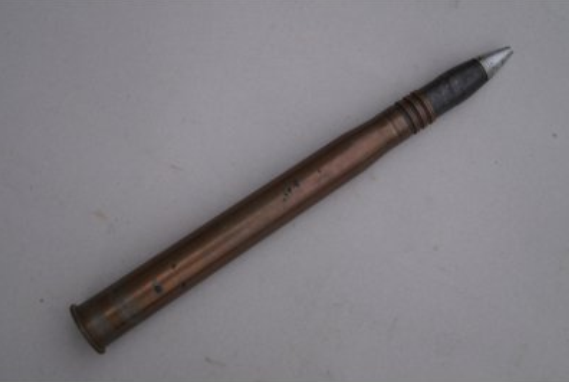
In terms of effective fire range and reach in height, the marine 37-mm gun was seriously superior to land anti-aircraft guns of the same caliber, but the 37x380R shot was not interchangeable with 37-mm anti-tank, anti-aircraft and aviation guns. According to German data, at a range of 2000 m in accuracy of 3,7 cm SK C / 30 was twice as high as the towed anti-aircraft gun 3,7 cm Flak 18.
The paired anti-aircraft gun 3,7 cm SK C / 30 paradoxically combined the most advanced design ideas with frankly archaic technical solutions. So, in the middle of the 30's, the Germans became pioneers by installing an 37-mm marine bridge on a platform stabilized in three planes. The twin stabilized anti-aircraft gun received the designation Dopp.LC/30 (German Doppellafette C / 30 - Two-gun carriage of the 30 model of the year). With a total mass of 3670 kg, almost 20% of the unit weight (630 kg) was the weight of the stabilization power drives, which could compensate for the slope from the ship’s rolling and pitching motion within +/- 19,5 °. Corners of vertical guidance: from -9 ° to + 85 °, and in the horizontal plane circular firing was provided. The twin implements had a hydraulic anti-recoil mechanism and a spring-mounted nakatnik. The paired 37-mm anti-aircraft guns initially did not have any armor, not counting the 14-20 mm steel “breastwork” on cruisers and battleships. However, since 1942, these installations have been equipped with 8-mm armored steel shields.
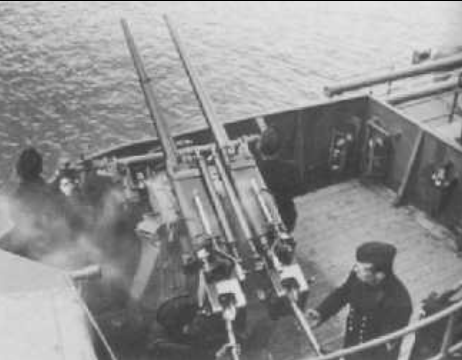
Although the German Navy Spark surpassed all 37-37-mm ship and land anti-aircraft guns existing at that time in accuracy of shooting the 40-mm, it had a semi-automatic vertical sliding wedge gate with manual loading of each shot. At the same time, the practical rate of fire of the paired anti-aircraft gun directly depended on the level of fitness of the calculation and in most cases did not exceed 60 rpm, which was almost two times less than that of the ground 3,7 cm Flak 18 anti-aircraft gun. Despite this, the twin 37-mm unit was manufactured in large series, was widely used in the German fleet and was used on most German class warships from destroyers and above. The destroyers carried such systems on 2, on light cruisers there were 4 sparks, on heavy cruisers on 6, on battleships there were 8 paired installations. Very often they were placed on large mobilized ships of the merchant fleet that were used for military transport. The production of 3,7 cm SK C / 30 was completed in 1942 year, about 1600 single and twin guns were produced.
After the outbreak of hostilities, it turned out that with strong agitation and splashing, the stabilization system often fails due to the ingress of sea water into electrical circuits. Moreover, with the intensive maneuvering of destroyers attacked by enemy aircraft, weak electric drives did not always have time to compensate for angular accelerations. Numerous failures in the work of the stabilization system and low Combat rate was the reason that the Germans in 1943 year began to replace the decks of warships semiautomatic gun 3,7 cm SK C / 30 37-mm single and twin anti-aircraft guns 3,7 Cm Flak M42 and 3,7 Cm Flak M42 . These automatic guns were created by Rheinmetall for the needs of Kringsmarine on the basis of the artillery part of the 3,7 anti-aircraft machine Flak 36.
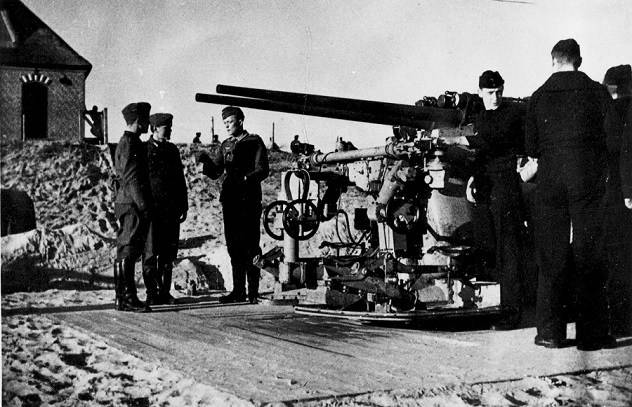
After the dismantling of the unnecessary stabilization system by the released anti-aircraft installations, the air defense of naval bases and ports was reinforced. Due to the absence of wheel carriages, the rather heavy Dopp.LC/30 two-way guns were placed in stationary positions, and they also armed railway anti-aircraft batteries.
Single 37-mm semi-automatic Einh.LC/34 guns (Einheitslafette C / 34 - One-gun carriage of the 34 model) were installed on various auxiliary ships of small displacement with -10 ... + 80 °. The tool was aimed horizontally at the expense of its free rotation in the horizontal plane with the help of the shoulder rest.
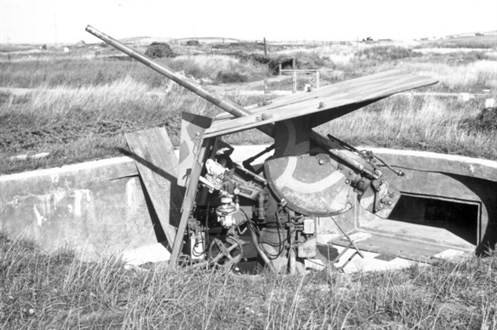
For vertical guidance there was a gear lifting mechanism. The weight of a single unit did not exceed 2000 kg. An armored shield was used to protect the calculation from bullets and shrapnel from 1942.
In 1939, the single-barreled 37-mm universal Ubts.LC/39 artillery system with an 3,7 cm SK C / 30U cannon was adopted for arming submarines. The mass of this installation was reduced to 1400 kg, and the maximum angle of vertical guidance was reduced to 90 °. In addition, corrosion resistant alloys were used in the design of Ubts.LC/39. Although the combat rate of fire of a semi-automatic gun did not exceed 30 rds / min, it was more reliable and compact than anti-aircraft guns used on land, and could be quickly brought into a combat position. Conceptually, the German 37-mm universal artillery mount was close to the Soviet 45-mm semi-automatic 21-K universal gun, but had better ballistics and rate of fire.
37-mm universal installation Ubts.LC/39, used in antiamphibious defense on the line of the "Atlantic Wall"
Since 1943, a significant number of Einh.LC/34 and Ubts.LC/39 installations have been transferred to air defense units and housed in fortifications of the Atlantic Wall. Although by the year 1945 single and twin semi-automatic 37-mm universal guns were considered obsolete, their operation continued until the end of hostilities.
In addition to 37-mm anti-aircraft installations made at their own enterprises, there were quite a few captured guns of the same caliber in the armed forces of Nazi Germany. First of all, we should mention the Soviet 37-mm automatic anti-aircraft gun model 1939 of the year, which is also known as 61-K.
After plant them. Kalinin No. 8 in the Podlipki suburban area in the first half of the 30 failed to master the serial production of the 37-mm anti-aircraft machine, documentation and semi-finished products to which were obtained from Rheinmetall, in the USSR in the year 1939 adopted the 37-mm copy of the 40-mm automatic anti-aircraft gun Bofors L60. According to its characteristics, the Soviet 37-mm anti-aircraft gun was close to the Swiss prototype. The mass of the 61-K in a combat position without a shield was 2100 kg, the combat rate of fire was up to 120 rds / min. Vertical guidance angles: from −5 to + 85 °. Loading was done with 5 clips shots, the weight of the clips with cartridges - more than 8 kg. The 732 g fragmentation tracer grenade had an initial speed of 880 m / s, and a tabular range to 4000 m. A solid armor-piercing tracer with a mass of 770 g with an initial speed of 870 m / s, at a distance of 500 m normal could penetrate 45 mm armor . Compared to the German 37-mm 3,7 anti-aircraft machine, the Flak 36 Soviet 37-mm automatic anti-aircraft gun model 1939, had a slight advantage in ballistic characteristics. The 3,7 combat rate of fire with m Flak 36 and 61-K was about the same. The German anti-aircraft gun had a more compact and convenient biaxial carriage, which could be towed with greater speed.
From 1939 to 1945, more than 12 000 37-mm 61-K guns were delivered to the Red Army anti-aircraft units. As of 22 June 1941, the troops had about 1200 anti-aircraft guns. During the fighting, the Germans succeeded in capturing up to 600 Soviet 37-mm anti-aircraft guns, which were adopted by the Wehrmacht under the designation 3,7 cm Flak 39 (r).
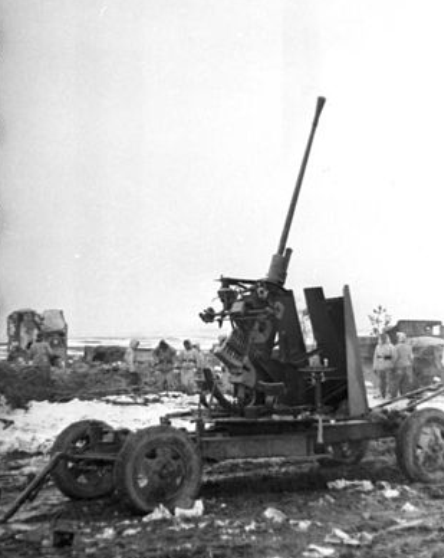
However, in the second half of the war the Germans experienced a serious shortage of ammunition for captured Soviet 37-mm anti-aircraft guns, which limited their use for their intended purpose. In this regard, in 1944, most of the captured 61-K anti-aircraft guns were used as anti-tank guns in fortified areas.
After the withdrawal of Italy from the war in September 1944, more than 100 37-mm 37 mm / 54 Breda Mod. 1932 / 1938 / 1939, which received the German designation 3,7 cm Flak Breda (i).
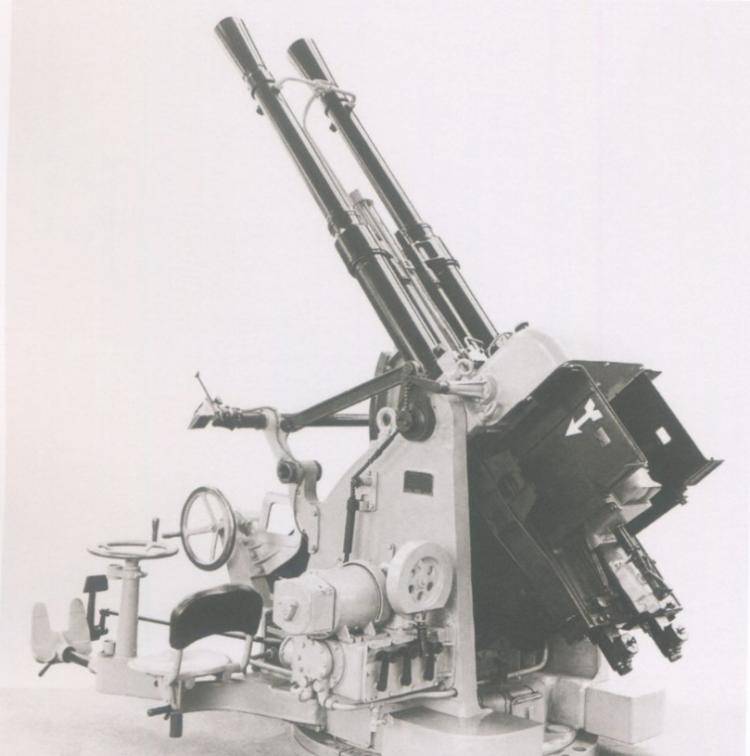
The 37-mm anti-aircraft machine gun was created by Breda by scaling the 13,2-mm machine gun Hotchkiss M1930 machine gun, ordered by the Italian Navy to replace the outdated British 40-mm naval anti-aircraft gun QF 2 pounder Mark II. For a new naval rapid-fire cannon was adopted ammunition 37x232mm SR. Charging was carried out from the box stores for six shots. The rate of artillery gun shooting could be adjusted from 60 to 120 rds / min. High-explosive projectile mass 820 g left the barrel with an initial velocity of about 800 m / s. The firing range of the air targets was up to 4000. The sea twin Breda 37 / 54 mod 1932 installation on the stationary pedestal weighed about 4 tons.
Although paired 37-mm anti-aircraft "Breda" arr. 1932 and 1938 could produce more 160 projectiles per minute, they had an increased vibration when firing bursts, which significantly reduced their accuracy. In this regard, in 1939, the single-barrel installation 37 mm / 54 Breda mod. 1939 with shells on the left. The gun was originally produced in the stationary version on a tube gun carriage designed to be placed on the ship’s deck or stationary positions.
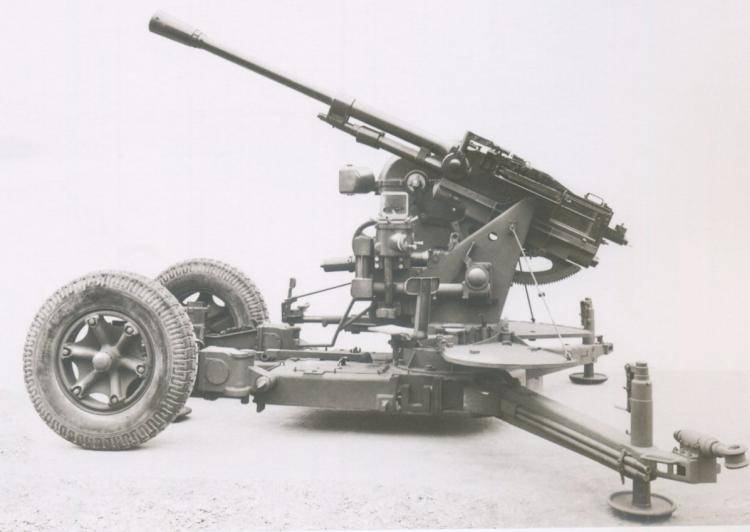
In 1942, the 37-mm anti-aircraft guns on the original uniaxial gun carriage and wagons borrowed from captured Bofors 40-mm went into the series. The weight of the anti-aircraft installation in a combat position on a biaxial gun carriage was 1480 kg, on the Bofors cart - 1970 kg. Vertical pickup angles range from -10 / + 80 degrees.
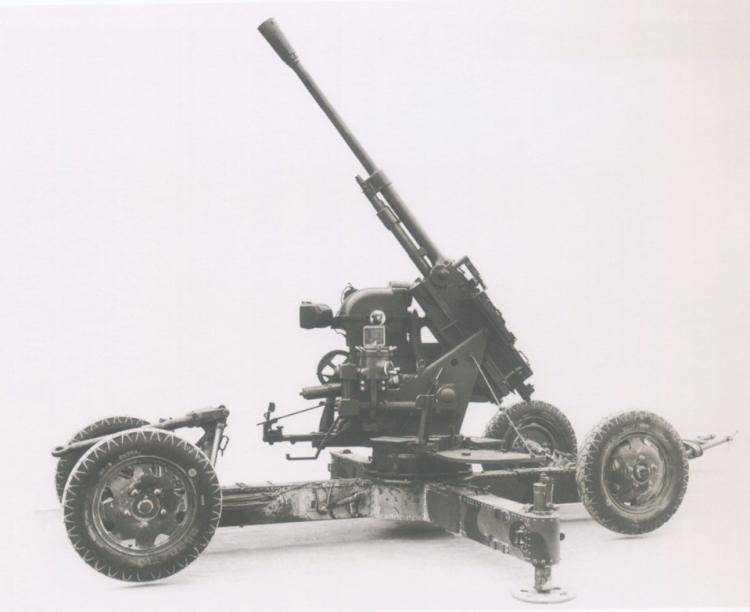
Talking about small-caliber anti-aircraft installations used by the Germans during the war years, it is impossible not to mention the truly “international” model - the 40-mm Bofors L60 submachine gun. A number of sources state that its design began during the First World War. In 1918, the specialists of the Friedrich Krupp AG concern worked on a prototype of a rapid-fire anti-aircraft gun with automatic, based on the use of recoil of the barrel with a short rollback. Due to the restrictions imposed by the Versailles Treaty on Germany, the existing anti-aircraft guns were allegedly transferred to the Swedish company AB Bofors, which in turn brought the gun to the required level of reliability and in the 1932 year offered to potential buyers. Initially, the Swedish Navy became interested in 40-mm machine guns, but 40-mm and 20-mm anti-aircraft guns were competing with the 25-mm "Bofors". As is often the case, recognition at home occurred much later than abroad. The first customer of the L60 anti-aircraft machine guns in 1932 was the Dutch fleet, which installed 5 twin 40-mm installations on the light cruiser De Ruyter. Anti-aircraft guns were mounted on a stabilized installation, developed by the Dutch company Hazemeyer.
In the 1935, the land version of this tool appeared. It was mounted on a two-axle towed wagon, which, when transferred to the combat position, was hung on jacks. In the case of urgent need, the shooting could be conducted directly "from the wheels", without additional procedures, but with less accuracy. The weight of the anti-aircraft installation in the combat position is about 2400 kg. Vertical guidance angles: from −5 ° to + 90 °. Rate of Fire: 120 to 140 rds / min. Combat rate - about 60 rds / min. Calculation: 5-6 people. The anti-aircraft gun was loaded from a vertically inserted holder on an 4 cartridge.
For an anti-aircraft installation created in Sweden, a 40x311R shot with various types of shells was adopted. The main tracer was the fragmentation-tracer 900 of the projectile equipped with 60 of TNT leaving the barrel at a speed of 850 m / s. A solid armor-piercing tracer 40-mm projectile with a mass of 890 g, with an initial speed of 870 m / s, at a distance of 500 m could penetrate 50 mm armor. In terms of effective shot and projectile mass, the Bofors L60 anti-aircraft gun slightly exceeded the German and Soviet 37-mm 3,7 сm Flak 36 and 61-K automatic rifles, it had approximately the same combat rate of fire, but it was heavier.
In the second half of the 30's towed and sea 40-mm anti-aircraft guns from Bofors were popular with foreign customers. In Europe, before the start of the Second World War, they were purchased or licensed for mass production: Austria, Belgium, Great Britain, Hungary, Greece, Denmark, Italy, the Netherlands, Norway and Poland, Finland, France and Yugoslavia.
The Wehrmacht became the owner of the 40-mm "Bofors" in 1938, when, as a result of the Anschluss, the Austrian army received 60 anti-aircraft guns. In Germany, these anti-aircraft guns were designated as 4,0 cm Flak 28. After the occupation of Belgium, Holland, Greece, Denmark, Norway, Poland, France and Yugoslavia, around the Bofors L400 anti-aircraft guns were at the disposal of the German army. Moreover, after the German occupation, the mass production of 60-mm anti-aircraft guns was continued at the enterprises: Österreichinschen Staatsfabrik in Austria, Hazemeyer BV in the Netherlands, Waffenfabrik Kongsberg in Norway. The Hungarian metallurgical and engineering consortium MÁVAG until December 40 put about 1944 1300-mm "Bofors". When the rate of production of anti-aircraft guns was quite high compared to other European countries, Hungarian engineers introduced many useful innovations, in particular, they developed and introduced into production a new rotary drive device for the rotating part of the installation, which reduced the pointing time in the horizontal plane. The peak of the Bofors production at the German-controlled enterprises was in March-April 40, when the customer surrendered up to 1944 anti-aircraft guns per month.
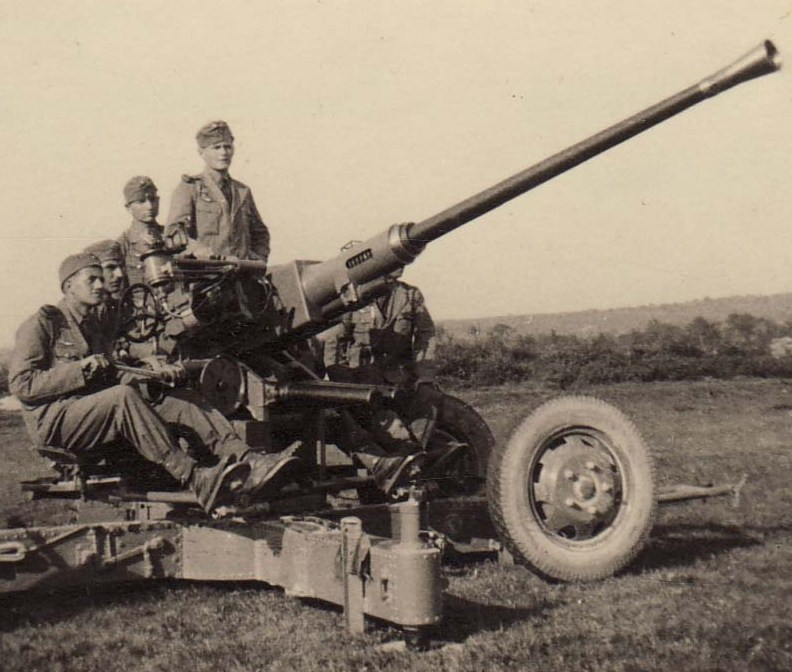
In total, the Wehrmacht and Kringsmarine had more than 2000 trophy and new 40-mm anti-aircraft guns, approximately 300 "Bofors" were in the anti-aircraft parts of the Luftwaffe. The release of ammunition for them was established at Renmetall plants. It should be noted that the Bofors L60 anti-aircraft guns, produced in different countries, were unified according to ammunition, but often, due to local design features and differences in manufacturing technology, they had non-interchangeable parts and assemblies. At the first stage, the German command solved this problem by deploying 40-mm anti-aircraft guns in the occupied countries, where they were made, which made it possible to repair and maintain the tools at local enterprises.
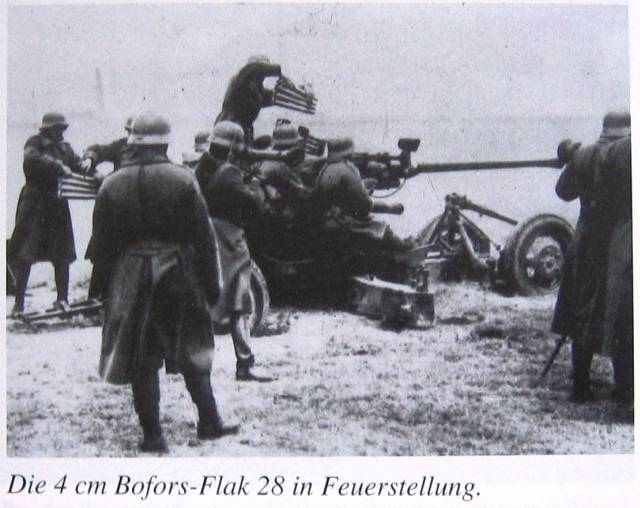
However, as the situation worsened on the fronts, due to the need to compensate for the losses incurred, the Bofors' anti-aircraft batteries were moved closer to the front line from the positions in the rear, which of course made them difficult to operate and reduced their combat readiness. At the final stage of the war, the Bofors, like other anti-aircraft guns, very often fired at ground targets.
A relatively obscure sample is the 50-mm automatic 5,0 anti-aircraft gun cm Flak 41 (Flugabwehrkanone 41). The development of this tool began in the middle of 30-x, when the military noticed that between 20-37-mm machine guns and 75-88-mm semi-automatic guns at altitudes from 2000 to 3500 m there is a gap in which rapid-caliber machine guns are not so effective , and for heavy anti-aircraft guns with remote fuses, this height is still small. To solve the problem, it seemed justified to create anti-aircraft guns of some intermediate caliber, and the designers of the Rheinmetall concern Borsig AG opted for an 50-mm 50xXNNUMXB shot.
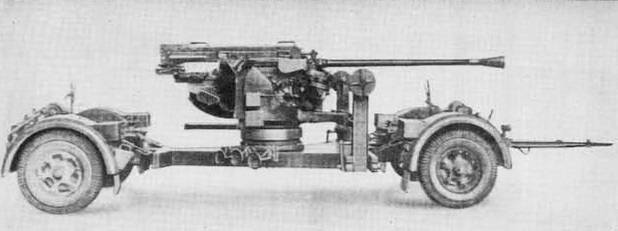
Tests of the prototype 50-mm anti-aircraft guns began in the 1936 year, and five years later the weapon was adopted. 5,0 guns cm Flak 41 entered the Luftwaffe anti-aircraft divisions, which protected important strategic assets.
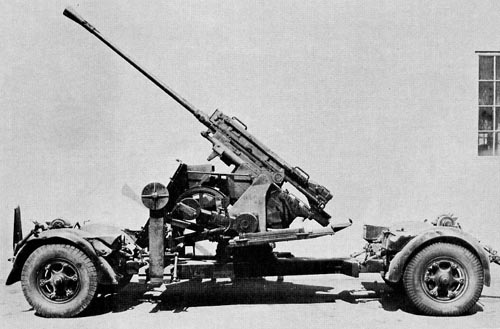
The operation of the 5,0 automatics cm Flak 41 was based on a mixed principle. The unlocking of the bore, the extraction of the liner, the throwing of the bolt back and the compression of the spring of the bolt tensioner were due to the powder gases discharged through the side bore in the barrel. And the flow of ammunition was carried out due to the energy of the rolling back barrel. The barrel was locked with a wedge sliding gate. The power supply of the machine by the cartridges is lateral, on the horizontal supply table using a clip for 5 or 10 cartridges. Rate of fire - 180 rds / min. Real combat rate did not exceed 90 rds / min. Vertical guidance angles: from - 10 ° to + 90 °. Fragmentation tracer, weighing 2,3 kg left the barrel at a speed of 840 m / s and could hit targets flying at heights up to 3500 m. The self-destruction of the projectile occurred at a distance of 6800 m. Also, the ammunition could include armor-piercing high-explosive tracer shells with armor penetration. 500 m normal 70 mm.
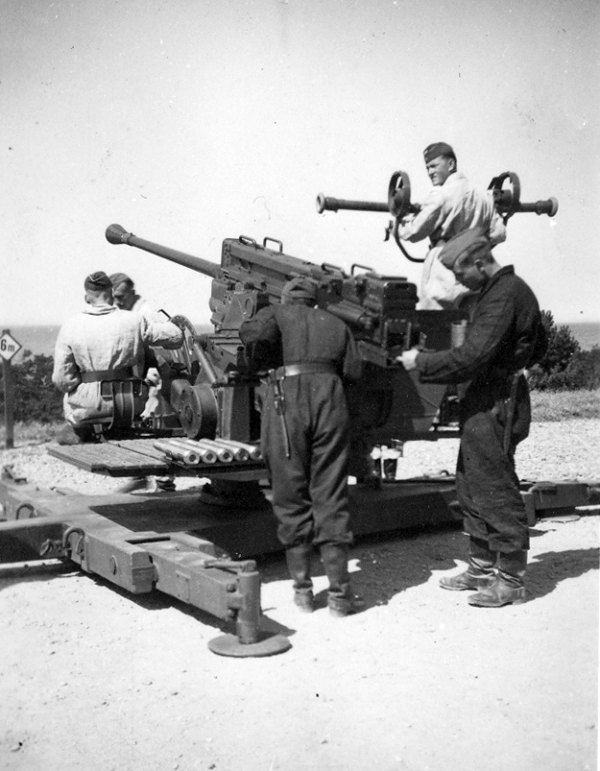
Installation was transported on a two-axle carriage. In a combat position, both wheel travels rolled back, and the cruciform base of the mast was leveled with jacks. The gun turned out quite heavy, its weight in the combat position was 4300 kg. Calculation - 7 people. The transfer time from transport to combat is 5 minutes.
In connection with its purpose, 50-mm anti-aircraft guns were mainly located in stationary positions. However, a number of 5,0 cm Flak 41 installed on all-wheel drive trucks Mercedes-Benz L-4500A.
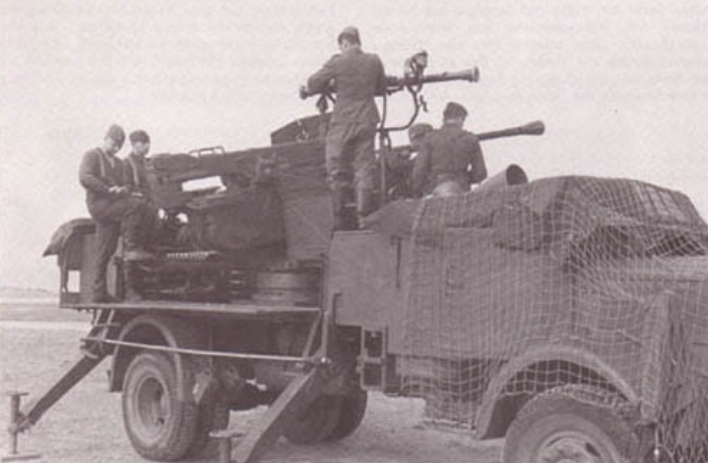
Due to the strong recoil, before firing in order to avoid tipping over on the improvised ZSU it was necessary to tilt the additional side supports. The metal sides of the cargo platform, laid out in a horizontal plane, when casting the installation into a firing position, formed an additional platform. In addition to the anti-aircraft gun in the back was also an optical rangefinder.
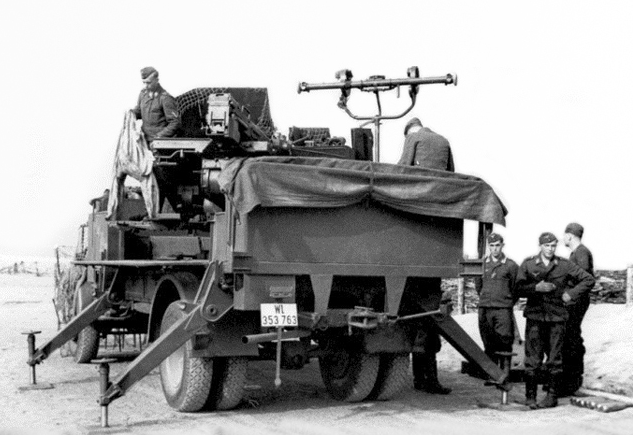
Details of the combat use of ZSU with 50-mm anti-aircraft guns are not known, but judging by the preserved photos, 5,0 cm FlaK 41 were installed on machines with light armor protection of the cab and engine compartment. There were also unarmored options with a fully open cockpit.
In various sources, the number of 50-mm anti-aircraft guns released ranges from 50 to 200 units. This series, insignificant by the standards of military time, is explained by the fact that the 5,0 cm FlaK 41 cannon was unsuccessful. The main complaints were related to ammunition. Even in the afternoon, the flashes of shots strongly blinded the calculation, and the shells for such a caliber turned out to be thin. The four-wheeled carriage was too heavy and bulky when moving on dirt roads. In addition, the shelling of fast moving targets was hampered due to too low a horizontal pickup speed. However, 50-mm anti-aircraft guns were used until the surrender of Germany. In the Ruhr area, 24 guns stationed in stationary positions became American trophies.
Assessing the actions of the German small-caliber anti-aircraft artillery, it is worth noting its very high efficiency. The anti-aircraft cover of the German troops was much better than the Soviet, and this situation persisted throughout the war. In the comments to the part devoted to 20-mm anti-aircraft guns, one of the readers spoke as follows:
However, the statistics of combat losses suggests otherwise. It was the fire of small-caliber anti-aircraft guns that destroyed most of the IL-2 lost for military reasons. Authors V.I. Perov and O.V. Rastrenin in his book "Attack Il-2" give the following data:
From the above, we can conclude that the enemy partially compensated the final loss of air supremacy in 1944 by increasing the number of rapid-fire anti-aircraft guns in the front-line area. 88-105-mm anti-aircraft guns in most cases inflicted damage to our attack aircraft only with the first volley and at a distance of no more than 8 km. The high losses of attack aircraft from 20-40-mm anti-aircraft guns are explained by the specifics of their combat use. Unlike bomber and fighter jets, they operated mainly from low altitudes - which means that more often and longer than other aircraft, they were in the realm of real German MZA fire. The extreme danger that German small-caliber anti-aircraft guns posed to our aircraft was largely due to the perfection of the material part of this weapons. The design of anti-aircraft installations made it possible to maneuver very quickly the trajectories in the vertical and horizontal planes. As a rule, as part of the anti-aircraft battery, the fire was corrected with the help of PUAZO, which gave corrections for the range, speed and course of the aircraft. In the case of individual use, each gun was in most cases equipped with an optical rangefinder, which made it possible to make corrections in range. German anti-aircraft calculations had a very high level of training, so that the shooting accuracy was high and the reaction time was short. The first accurate shot of the German small-caliber anti-aircraft battery was ready to give within 20 seconds after the discovery of Soviet aircraft. The Germans introduced corrections for change of course, dive angle, speed, distance to the target within 2 — 3 seconds. Correction of anti-aircraft fire was facilitated by the wide use of tracer projectiles. The average probability of hitting a X-NUMX-mm Flak 20 single-barrel machine gun on an aircraft flying at a speed of 38 km / h at a distance of 400 m was 1000. With the increase in the number of anti-aircraft guns or the use of multi-barred installations, the probability of defeat increased accordingly. The enemy's air defense system had a very high saturation of anti-aircraft guns. The number of barrels covering the objects of the Il-0,01 attacks increased continuously, and at the beginning of 2 an 1945-150 200-20-mm projectiles could be launched per second at an attack aircraft operating in the German fortified area. The concentration of the fire of several guns on one target also increased the likelihood of defeat. In addition, in most cases, IL-37 and IL-2 made several passes on the target, and the German anti-aircraft gunners managed to get their shot.
Based on:
http://militera.lib.ru/tw/perov_rastrenin/index.html
http://wwii.space/zenitnyie-orudiya-germaniya/
https://bunkermuseumhanstholm.dk/de/museumrundgang/das-dokumentationszentrum/wrackstueck-von-hudson-hanstholm-5-april-1942/
http://www.atlantvoldsydvest.dk/2017/11/10/ubungsbatterie-fano-5-le-leichte-flakausbildungskompanie-der-marine-flakschule-iii-1943-45/
http://forums.airbase.ru/2007/08/t56936_2--zenitnaya-artilleriya-vtoroj-mirovoj.html
http://www.navweaps.com/Weapons/WNGER_37mm-69_mk42.php
https://military.wikireading.ru/7543
http://www.navweaps.com/Weapons/WNIT_37mm-54_m1932.php
http://weaponews.com/weapons/10898-stories-about-guns-anti-aircraft-gun-bofors-40-mm-l60.html
http://www.cmchant.com/bofors-gun-the-l60-weapons
http://www.lonesentry.com/ordnance/5cm-flak-41-antiaircraft-gun.html
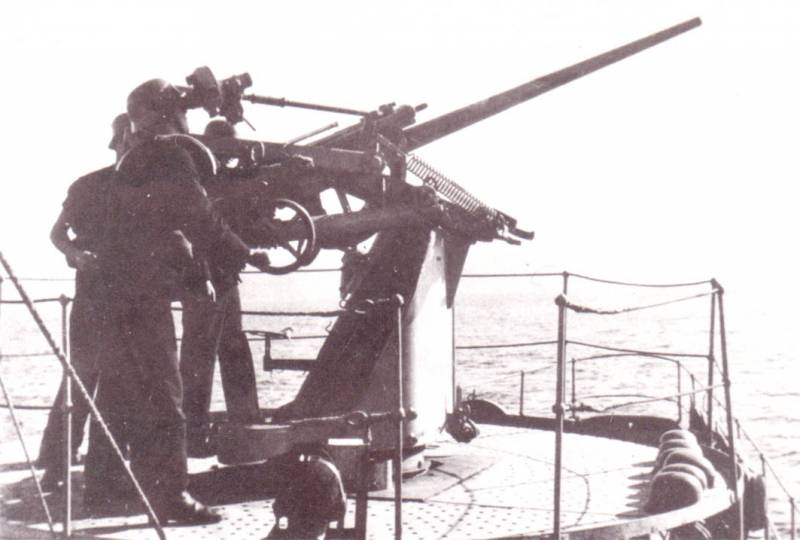
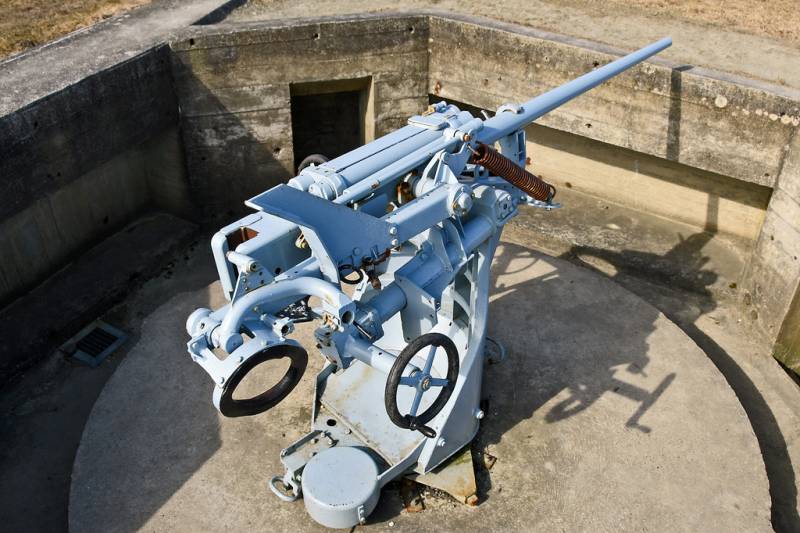
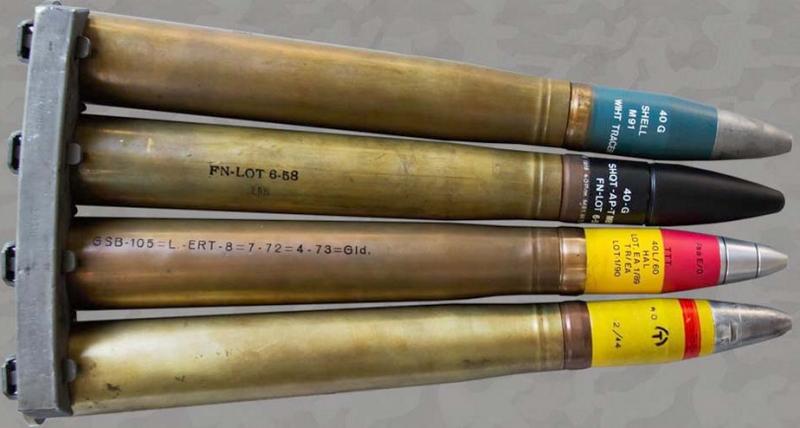
Information